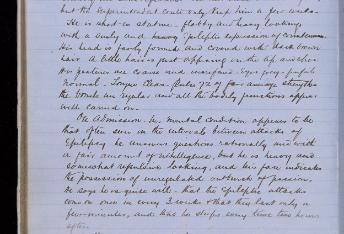Walter Freelove Brown
Walter Freelove Brown was admitted to The Retreat on 7 March 1874. Although he was from Kingston upon Thames, his membership of the Society of Friends allowed him to be admitted to the Quaker Asylum in York. Walter was just 15 years old when he entered the Retreat. His admission papers state that he had his first 'convulsive fit' at 6 months. These 'fits' had continued with occasional intervals of 12 months but latterly they had been more frequent.

(Click the image for a larger version)
Walter was suffering from epilepsy which, in 1874, was considered suitable for institutionalisation in an asylum. Indeed, when asked to state the 'causes of mental disorder' the surgeon has written 'No cause can be assigned but the recurrence of epileptic disease.'
The surgeon admitting a patient was obliged to fill out a section entitled 'Fact indicating insanity observed by myself'. He writes:
“Very excitable in conversation and gesture repeatedly opening and shutting doors violently, pulling his mother about in a rude manner. When asked why he was so troublesome he suddenly and in an excited state ran up stairs, shut himself in a room and barricaded the door with a heavy box then began crying in a loud manner.”

(Click the image for a larger version and transcription)
Disturbingly, the distress of Walter, who was still a child, at being admitted to The Retreat was itself taken as grounds for admission. It provides a compelling insight into the fear, and lack of care or sympathy for it, of a new patient.
Walter's case notes go on to describe his illness as 'Epileptic Mania' which was regarded as a highly unstable condition, with ‘mania’ bringing it firmly within the psychiatric category. The misunderstanding of Walter's condition is obvious. They begin by describing his appearance, in particular noting his “epileptic expression of countenance”, and later “he is heavy and somewhat repulsive looking, and his face indicates the possession of unregulated outbursts of passion”. They assess, although it is unclear how, that “his mental condition appears to be that often seen in the interval between attacks of epilepsy”.
Consistent with his distress at being admitted, Walter seemingly advocated that he did not require institutionalisation, implied in the final note that “he says he is quite well – that the epileptic attacks come on once in every three weeks and that they last only a few minutes, and that he sleeps every time two hours after.” The admission that he experienced episodes of epilepsy here may, however, have been sufficient to prompt the other ‘medical’ observations which justified his confinement.

(Click the image for a larger version and transcription)
Walter remained in The Retreat for fourteen years, until his death in February 1888. The surgeon wrote “Today I was called to Walter Brown and found him dead. He had several rather severe fits lately and his death was due to cardiac failure whilst in a fit. Post Mortem revealed Heart Disease.” It is apparent that Walter was interred in the Retreat for care, not cure. The pressure on his family would have been enormous whilst he was at home so housing him in the Retreat looked after their interests as well.

